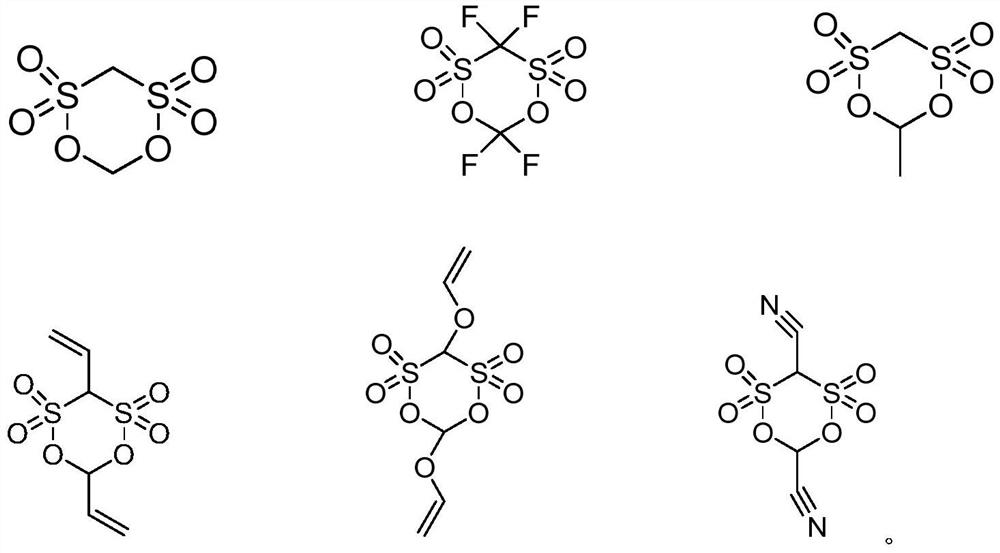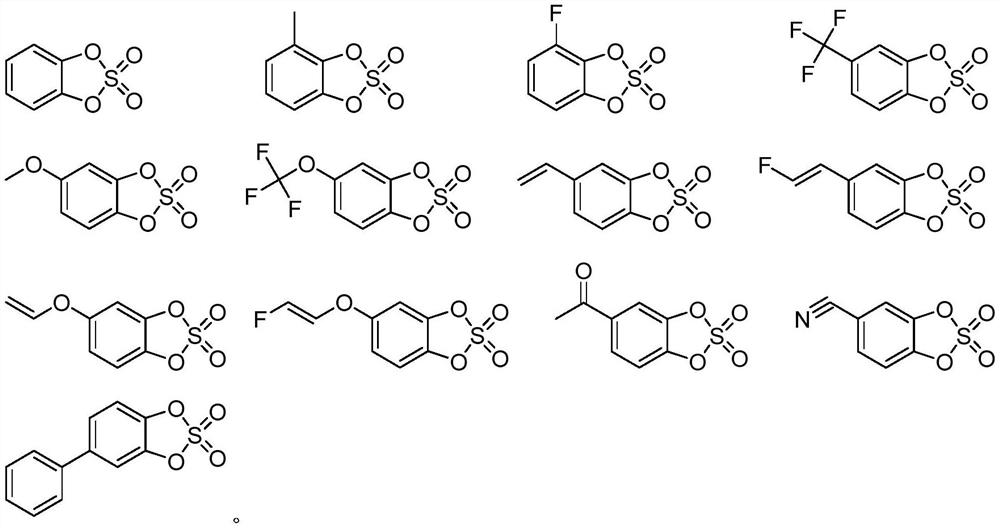Lithium ion battery electrolyte and application thereof
A lithium-ion battery and electrolyte technology, which is applied in the direction of secondary batteries, organic electrolytes, non-aqueous electrolytes, etc., can solve the problems of high volume expansion rate and internal resistance increase rate, unfavorable industrial manufacturing and practical application, unstable storage state, etc. problem, achieve the effects of reducing impedance, improving low-temperature charge and discharge performance, and improving cycle performance
- Summary
- Abstract
- Description
- Claims
- Application Information
AI Technical Summary
Problems solved by technology
Method used
Image
Examples
Embodiment 1
[0063]
[0064] In an argon atmosphere glove box with a water content 6 ) and 0.5 parts by mass of lithium difluorophosphate (LiPO 2 F 2 ) was dissolved in the above organic solvent, 0.5 parts by mass of compound A1, 1.0 parts by mass of compound B1, and 2.0 parts by mass of 2,4-butane sultone were added, and stirred at 200 rpm with a mixer for 30 minutes until uniform to obtain The lithium ion battery electrolyte of Example 1.
[0065]
[0066] (1) Preparation of positive electrode sheet
[0067]The positive active material nickel cobalt lithium manganate (NCM811), the conductive agent SuperP, carbon nanotubes, and the binder polyvinylidene fluoride (PVDF) were mixed with N-methylpyrrolidone ( NMP) mixed well to make a positive electrode slurry, coated on the current collector aluminum foil with a thickness of 100 μm, dried at 70 ° C, cold pressed at 4 Mpa at room temperature, and then trimmed, cut into pieces, and slit, and then welded. The tabs are made into positive...
Embodiment 2
[0073] The lithium ion battery electrolyte and lithium ion battery were prepared with reference to the method of Example 1, the difference is that when preparing the lithium ion battery electrolyte, 2.0 parts by mass of compound A2 and 2.0 parts by mass of compound B2 were added, and no other additives were added. .
Embodiment 3
[0075] A lithium ion battery electrolyte and a lithium ion battery were prepared with reference to the method of Example 1, except that, when preparing the lithium ion battery electrolyte, 0.2 parts by mass of compound A3, 0.5 parts by mass of compound B3, and 3.0 parts by mass were added 1,3-propane sultone.
PUM
 Login to View More
Login to View More Abstract
Description
Claims
Application Information
 Login to View More
Login to View More - R&D
- Intellectual Property
- Life Sciences
- Materials
- Tech Scout
- Unparalleled Data Quality
- Higher Quality Content
- 60% Fewer Hallucinations
Browse by: Latest US Patents, China's latest patents, Technical Efficacy Thesaurus, Application Domain, Technology Topic, Popular Technical Reports.
© 2025 PatSnap. All rights reserved.Legal|Privacy policy|Modern Slavery Act Transparency Statement|Sitemap|About US| Contact US: help@patsnap.com



